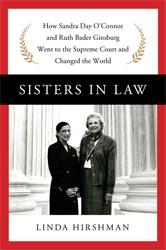Excerpted from Sisters in Law: How Sandra Day O’Connor and Ruth Bader Ginsburg Went to the Supreme Court and Changed the World by Linda Hirshman.
By the time the nation celebrates the birth of its democracy each Fourth of July, the nine justices of the Supreme Court have mostly left town. But before departing the capital for their summer recess, they must first decide all the cases they have heard since their current term began the previous October. The hardest, most controversial cases, where the unelected Court orders the society to change in a big way, are often left to the end. As the days for decision tick away in late June, the tension in the courtroom is as hot and heavy as the Washington summer air.
On the morning of June 26, 1996, Justice Ruth Bader Ginsburg, the second woman appointed to the high court since its founding, slipped through the red velvet curtain behind the bench and took her seat at the end. Five places along the majestic curve sat Justice Sandra Day O’Connor, since 1981 the first woman on the Supreme Court, or the FWOTSC as she slyly called herself. Each woman justice sported an ornamental white collar on her somber black robe, but otherwise there was no obvious link between the First and Second, any more than between any of the other justices. On that day, however, the public got a rare glimpse at the ties that bound the two most powerful women in the land.
Speaking from the depths of the high-backed chair that towered over her tiny frame, Justice Ginsburg delivered the decision of the Court in United States v. Virginia. From that morning in June 1996, Virginia’s state-run Virginia Military Institute, which had trained young men since before the Civil War, would have to take females into its ranks. The Constitution of the United States, which required the equal protection of the laws for all persons, including women, demanded it.
Women in the barracks at VMI. Women rolling in the mud during the traditional hazing, women with cropped heads and stiff gray uniforms looking uncannily like the Confederate soldiers VMI had sent to the Civil War a century before. Six of Ginsburg’s “brethren” on the Court agreed with her that VMI had to admit women, but the case was much more contentious — and momentous — than that robust majority of seven reflects. Until that day, VMI had been the shining symbol of a world divided between men’s and women’s proper roles. Before the case got to the Supremes, the lower federal courts had supported VMI’s sex-segregated ways. For years, opponents of feminism used the prospect of women in military settings as the prime example of how ridiculous the world would become if women were truly treated as equal to men. VMI was one of the last redoubts. And now Justice Ginsburg, who, years ago as Lawyer Ginsburg, had been the premier advocate for women’s equality — the “Thurgood Marshall of the women’s movement” — was going to order the nation to live in that brave new sex-equal world.
Few people listening knew that Ginsburg got to speak for the Court that morning, because her sister in law, O’Connor, had decided she should. After the justices voted to admit women to VMI at their regular conference, the most senior member of the majority had the right to assign the opinion to any justice who agreed. He assigned it to the senior woman, Sandra Day O’Connor, but she would not take it. She knew who had labored as a Supreme Court lawyer at the American Civil Liberties Union from 1970 to 1980 to get the Court to call women equal. And now the job was done. “This should be Ruth’s,” she said.
Copyright © 2015 by Linda Hirshman. Reprinted with permission from Harper, an imprint of HarperCollins Publishers.
Related Content:
Linda Hirshman is a lawyer and cultural historian and the author of Victory: The Triumphant Gay Revolution and many other books. She received her JD from the University of Chicago Law School and her PhD in philosophy from the University of Illinois at Chicago, and has taught philosophy and women’s studies at Brandeis University. Her writing has appeared in the New York Times, Washington Post,Slate, Newsweek, The Daily Beast, and POLITICO. She lives in Arizona and New York City.




